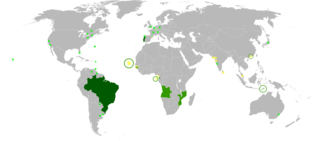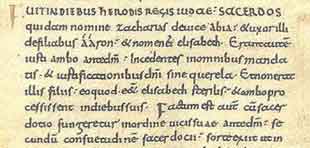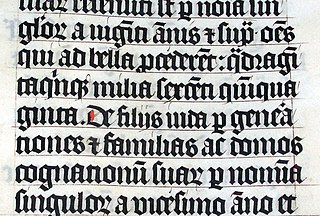
Johannine script (Portuguese : letra joanina) was a historical style of handwriting used in the Portuguese Royal Chancery starting around the reign of John I (1385–1433) that was used until the reign of Manuel I (1495–1521). It is, thus, a national variation of chancery hand, a form of blackletter.

Portuguese is a Western Romance language originating in the Iberian Peninsula. It is the sole official language of Portugal, Brazil, Cape Verde, Guinea-Bissau, Mozambique, Angola, and São Tomé and Príncipe. It also has co-official language status in East Timor, Equatorial Guinea and Macau in China. As the result of expansion during colonial times, a cultural presence of Portuguese and Portuguese creole speakers are also found in Goa, Daman and Diu in India; in Batticaloa on the east coast of Sri Lanka; in the Indonesian island of Flores; in the Malacca state of Malaysia; and the ABC islands in the Caribbean where Papiamento is spoken, while Cape Verdean Creole is the most widely spoken Portuguese-based Creole. Reintegrationists maintain that Galician is not a separate language, but a dialect of Portuguese. A Portuguese-speaking person or nation is referred to as "Lusophone" (Lusófono).

Palaeography (UK) or paleography is the study of ancient and historical handwriting. Included in the discipline is the practice of deciphering, reading, and dating historical manuscripts, and the cultural context of writing, including the methods with which writing and books were produced, and the history of scriptoria.
Chancery is a general term for a medieval writing office, responsible for the production of official documents. The title of chancellor, for the head of the office, came to be held by important ministers in a number of states, and remains the title of the heads of government in modern Germany and Austria. Chancery hand is a term for various types of handwriting associated with chanceries.
Johannine script is essentially cursive, with a short corpus size (but with long ascenders and descenders), letters slope slightly to the right, words are clearly separated one from the other with no ligatures, punctuation is mostly absent, and Arabic numerals are not used (instead, numbers are given in full, or in Roman numerals). The shape of the letters v and b (and Roman numeral 5) are practically indistinguishable. Abbreviations are commonplace, mostly marked with an overline and/or superscript. [1]

In typography, the x-height, or corpus size, is the distance between the baseline and the mean line of lower-case letters in a typeface. Typically, this is the height of the letter x in the font, as well as the v, w, and z. One of the most important dimensions of a font, x-height is used to define how high lower-case letters are compared to upper-case letters.

In typography, an ascender is the portion of a minuscule letter in a Latin-derived alphabet that extends above the mean line of a font. That is, the part of a lower-case letter that is taller than the font's x-height.
In typography, a descender is the portion of a letter that extends below the baseline of a font. The line that descenders reach down to is known as the beard line.
The prevailing script in documents from (and from the land that would eventually become) Portugal from the 8th to the 12th centuries was Visigothic script; from the mid-12th century onwards, for about a century, Carolingian minuscule and, later on, an incipient Gothic script. From 1385 onwards, that is, after John I was crowned putting an end to the Portuguese Interregnum, there is radical change in the writing style of the documents issued by the Royal Chancery: this new script (first called "Johannine script" by paleographer Eduardo Borges Nunes) [2] has influences of the French lettre bâtarde and Gothic scripts.

Visigothic script was a type of medieval script that originated in the Visigothic kingdom in Hispania. Its more limiting alternative designations littera toletana and littera mozarabica associate it with scriptoria specifically in Toledo and with Mozarabic culture more generally, respectively.

Carolingian minuscule or Caroline minuscule is a script which developed as a calligraphic standard in Europe so that the Latin alphabet of Jerome's Vulgate Bible could be easily recognized by the literate class from one region to another. It was developed for the first time, in about 780, by a Benedictine monk of Corbie Abbey, namely, Alcuin of York. It was used in the Holy Roman Empire between approximately 800 AD and 1200 AD. Codices, pagan and Christian texts, and educational material were written in Carolingian minuscule throughout the Carolingian Renaissance. The script developed into blackletter and became obsolete, though its revival in the Italian Renaissance forms the basis of more recent scripts.

The Gothic alphabet is an alphabet for writing the Gothic language, created in the 4th century by Ulfilas for the purpose of translating the Bible.
Notable scribes who wrote mostly on Johannine script include Álvaro Gonçalves (fl. 1385–1401), Gonçalo Caldeira (fl. 1386–1426), and João de Lisboa (fl. 1388–1431). [1]
Floruit, abbreviated fl., Latin for "he/she flourished", denotes a date or period during which a person was known to have been alive or active. In English, the word may also be used as a noun indicating the time when someone flourished.














